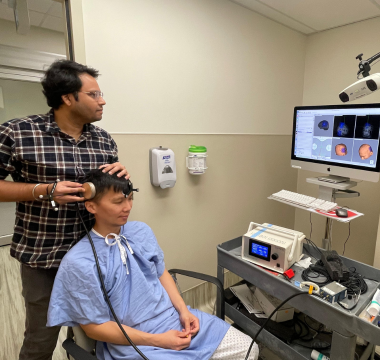Meet a Researcher Using Ultrasound Stimulation to Address Freezing of Gait

Freezing of gait is a common Parkinson’s disease (PD) symptom where a person experiences the temporary, involuntary inability to move. This can make simple activities, like walking across a room, incredibly challenging and dangerous due to the risk of falls. Unfortunately, common Parkinson’s medications often don’t alleviate these freezing episodes. This has led researchers like Amitabh Bhattacharya, PhD, from the University Health Network (UHN) in Canada, to explore new treatments.
What is a transcranial ultrasound stimulation (TUS)?
- Transcranial: “Through the skull,” noninvasively
- Ultrasound: A high-frequency soundwave safe for brain stimulation
- Stimulation: The use of the ultrasonic soundwaves to activate neurons

Dr. Bhattacharya is a recipient of a 2024 Parkinson’s Foundation Postdoctoral Fellowship, and will use this support to study how TUS can be utilized to help people with PD create personalized non-invasive treatments that targets freezing of gait.
“We will apply focused ultrasound waves to a specific part of the brain known as the pedunculopontine nucleus (PPN), a key region that helps control movement,” he said. “By precisely stimulating the PPN, we hope to make walking easier for people with Parkinson’s.”
Participants, recruited with help from the Toronto Western Hospital Movement Disorders Clinic, a Parkinson’s Foundation Center of Excellence, will first undergo a high-resolution brain scan to create a detailed map of their brain, focusing on the PPN. This personalized brain map will guide the ultrasound device to ensure that the sound waves are precisely directed to the right spot.
Each participant will receive three personalized TUS treatments, using different stimulation protocols to determine the most effective approach. To evaluate how well each protocol works, participants will be assessed before and after each session using tests that measure their walking ability, mental function, and brain activity.
Finally, Dr. Bhattacharya will have enough scientific evidence to determine the ability of TUS in improving freezing of gait, as well as how to keep improving the technique to make it even safer and more effective.
Dr. Bhattacharya is confident in this treatment’s potential to improve the lives of those experiencing PD-associated freezing of gait. “Targeting the PPN through non-invasive means such as TUS holds immense promise,” he said. “The ability of PPN-TUS to modulate these essential neural circuits could help restore a degree of normal motor function, thereby mitigating symptoms such as freezing of gait in PD.”
The goal of this study is to explore TUS as a practical and effective treatment for freezing of gait in Parkinson’s Disease. TUS is a non-invasive approach that could offer a quicker, more accessible, and cost-effective option for patients. By avoiding the complexities and recovery time associated with surgical procedures like deep-brain stimulation (DBS), TUS has the potential to enhance mobility and improve quality of life. The accessibility of this new potential treatment is top-of-mind for Dr. Bhattacharya.
“PPN-TUS offers a non-invasive, cost-effective alternative with fewer potential complications compared to PPN-DBS,” he said. “This study could transform the way we help Parkinson's patients regain their mobility. If successful, this non-invasive method may eventually become a standard treatment, offering improved quality of life for individuals with Parkinson’s disease.”
Meet more Parkinson’s researchers! Explore our My PD Stories featuring PD researchers.
Related Materials
Related Blog Posts

Top Parkinson’s Science News Articles of 2025

Celebrating 12 Milestones that Defined 2025
